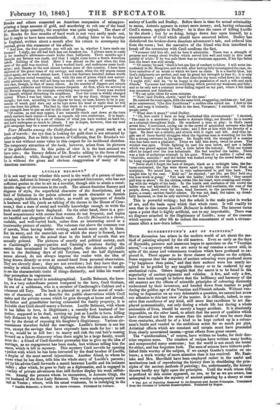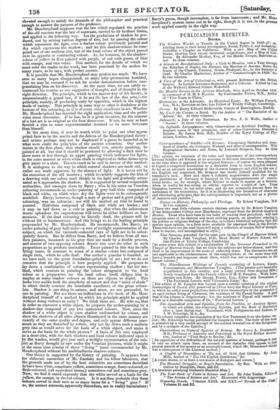HUNDERTPPUND'S ART OF PAINTING. * Muca discussion has arisen in the
modern world of art about the me- thod of painting adopted by the old masters. Even so early as the days of Reynolds, painters and amateurs began to speculate on the "Venetian secret,"—a mystery which we are sorry to say remains a secret still, in spite of the many and voluminous treatises which have professed to ex- pound it. There appear to be three classes of opinion on the subject. Some suppose that the miracles of ancient colouring were produced more "by happiness than pains," and that their authors were too nearly in- spired to be guided by any tangible theory or to be enslaved by any mechanical rules. Others imagine that the secret is to be found in the superiority of ancient pigments and vehicles. A few, and only a few, have been bold enough to believe that the brilliancy and harmony of the old masters are the effects of scientific principles of colouring distinctly understood by their inventors, and banded down from teacher to pupil during the golden age of the Venetian and Flemish schools. Without ven- turing to dogmatize on so very debateable a question, we cannot but avow our adhesion to this last view of the matter. It is difficult, indeed, to con- ceive that excellence of any kind, still more that excellence in art dis- played systematically, not only during a whole life but during a whole succession of lives, should be merely a happy accident. It is absolutely impossible, on the other hand, to admit that the secret of qualities which have charmed not less the senses than the minds of men for more than three centuries, should be of a kind to be kept corked up in a colons- man's bottle and vended to the ambitious artist for so much per pint. Artistical effects which are constant and certain must have proceeded from clearly ascertained causes,—great effects from great causes. The "accidentalists," of course, have written no books, for their doc- trine requires none. The retailers of recipes have written many books, and compounded many nostrums; but the world is not much the better for either, and has forgotten both. The men of science have hitherto pub- lished little worthy of the subject, if we except Goethe's treatise on co- lours ; a work worthy of more attention than it has received. Mr. East- lake and Mrs. Merrifield have been employed rather in the useful and meritorious task of reproducing the history than in elucidating the prin- ciples of the ancient methods of painting; for, unfortunately, the history throws hardly any light upon the principles. Until the work whose title is prefixed to this notice appeared, no one, so far as we are aware, has attempted to explain the mystery of ancient painting by a theory at once
* The Art or Painting Restored to Its Simplest and Surest Principles. Translated from the German of Libertat Liundertpilind. Published by Bogue. elevated enough to satisfy the demands of the philosopher and practical enough to answer the purpose of the professor. Mr. Hundertpfund supposes that the law which regulated the practice Of the old masters was the law of contrasts, carried to its furthest limits, and applied in the following way. Let the gradations of shadow be pro- duced, not by mixing various degrees of tint, but by passing the colour which represents the light, over a darker colour previously painted and dry which represents the shadow; and let this shadow-colour be com- posed not of one uniform tint, but of the local colour of the object passed over its apposite or contrasting colour. As, for instance, let the shadow- colour of yellow be first painted with purple, of red with green, of blue with orange, and vice versa. This method, for the details of which we must refer the reader to the work, has been practised by the author for many years, as he says, with perfect success. It is possible that Mr. Hundertpfund may profess too much. We have seen so many hopes disappointed, so many lofty pretensions humbled, that we may be excused if we ask for ocular demonstration before con- gratulating him on his discovery. At the same time, we can safely re- commend his treatise as one suggestive of thought, and of thought in the right direction. The principle, which is the master-key of his theory, is unquestionably a grand law, if it be not the law of the fine arts,—the principle, namely, of producing unity by opposites, which is the highest mode of variety. This principle in some way or other is doubtless at the bottom of fine colouring, as it is of every other excellence in art. Whether Mr. Hundertpfund has detected the right application, time and the public voice must determine. If he has, he is a great inventor, for the restorer of a lost art is as original as the first discoverer. If not, he may at least famish a clue to some experimentalist destined to be more fortunate than himself.
In the mean time, it may be worth while to point out what appear prima facie to be the merits and the defects of the Hundertpfund theory : and artists perhaps may not be displeased if a guess be hazarded as to what were really the principles of the ancient colourists. Our author insists in the first place, that shadow should not, strictly speaking, be painted at all, but that it should be produced by allowing a dark tone to show more or less through an upper painting which indicates the lights, in the same manner as when white chalk is employed to define forms upon grey paper or a slate. There is much to be said in favour of this method. It is analogous to the way in which natural shadows are made out, or rather are made apparent, by the absence of light. It is borne out by the execution of the old masters ; which invariably suggests the idea of a drawing with one colour used thickly in the light and gradually atten- uated as it approaches the shadow. It is supported by several respectable authorities, and amongst them by Barry; who in his notes on Venetian colouring recommends an under-painting of grey half-tints composed of black and white, on which when dry the lights were to be subsequently modelled. Barry, however, though a man of genius and a good judge of colouring, was no colourist ; nor will his method on trial be found to succeed. Half-tints composed of black and white are leaden ; and it may be laid down as a rule in painting, that when the substratum wants splendour the superstratum will never be either brilliant or har- monious. If the dead colouring be literally dead, the picture will be without life or luminousness. And this brings us to the leading principle propounded by Mr. Hundertpfund. He recommends, like Barry, an under-painting of grey half-tints—a, sort of twilight representation of the subject, on which the variously-coloured rays of light are to be subse- qu ently drawn. But he differs from Barry, and we believe from all mo- dern painters, inasmuch as his grey tints are made by a double process, and consist of two opposing colours drawn one over the other in such proportions as to produce neutrality. Tones painted in this way he calls Hying tones, in contrast to tones of a similar colour but composed of single tints, which he calls dead. Our author's practice is founded, as we have said, on the great foundation-principle of art; but we do not conceive that the principle is here properly applied. He proposes to lay down a combination of colours representing shadow ; but his me- thod, which consists in painting the colour antagonist to the local colour as a preparation for the local colour itself, obliges him to employ as many shadow colours as there are objects to depict. This looks very unlike both the simplicity of nature and that " unity of shade" in which chiefly consists the inimitable excellence of the great colour- ists. Shadow is one thing in nature, and must, we are persuaded, be i
one n painting. Bat are there no indications in the book of Mr. Hun- dertpfcuid himself of a method by which his principle might be applied Without doing violence to unity? We think there are. He tells us, that In order to represent a white object, he prepares the under-painting by a shadow-tint composed of any two contrasted colours. Now, since the shadow of a white object is pure shadow undisturbed by colour, and since the shadows of all other objects illuminated in the same manner are exactly of the same quality and degree, and only appear different inas- much as they are disturbed by colour, why not lay down such a uniform grey tint as would serve for the basis of a white object, and make it se. rve as the basis for the whole picture? A basis of this sort employed as a demi-tint, with the dark shadows and local colours indicated upon it by flat washes, would give just such a twilight representation of the sub- ,
ject as Barry thought he saw under the Venetian pictures, while it might at the same time consist of those "living" tones recommended by Mr. Hundertpfund without his multitudinous shadow-colours.
Our theory is supported by the history of painting. It appears from the elaborate researches of Mr. Eastlake and his fellow labourers, that the grounds made use of by the best colourists are sometimes described to have been white, sometimes es yellow, sometimes orange, flame-coloured, or flesh-coloured, (all equivalent terms,) sometimes red and sometimes grey. Now, we find it stated expressly that the white served as a basis for the yellow, the orange, or the red colours. Is it not then probable that these colours served in their turn as so many bases' for a " living " ? If so, the ancient neonate; apparently discordant, are in reality harmonious; Barry's guess, though incomplete, is far from inaccurate ; and Mr. Rm. dertpfund's system turns out to be right, though it is notsin the present work applied exactly in the right way.



























 Previous page
Previous page